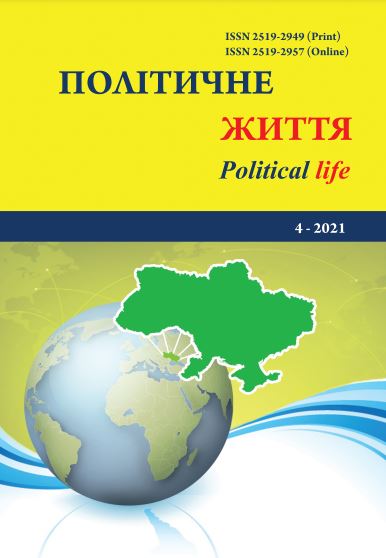Image making as a political technology: special features of the politicians’ long-term and short-term image building
DOI:
https://doi.org/10.31558/2519-2949.2021.4.7Keywords:
image making; image; political technology; identity; mediaAbstract
The present article analyzes the modern understanding of content of image-making as a political technology based on foreign and Ukrainian researchers’ studies. The authors focus on the special features of creating a politician’s long-term and short-term image. The main focuses and distinctions of various image-making techniques are determined. It is established that the short-term image-making prevails in the Ukrainian image-making practices. It is noted that the analysis of this problem is built mainly on interdisciplinary and communicative approaches, as well as on the use of comparative and systematic methods.
The twentieth century has changed the view of how an image of a politician should be built. Back in the first half of the twentieth century, advertising became a successful business and became a highly sophisticated tool for manipulation of the consumer’s mind. Such manipulations have quickly found their way from marketing sphere to political and interpersonal relations. With time, manipulative strategies became more widespread, and an individual was perceived less as a personality and became more of a "statistical unit" or an "abstract consumer of goods and services", who is to be involved in the advertising and political gaming. The image is based on a formal system of roles that a person plays in his life, complemented by features, character traits, appearance, clothing.
The image is formed both on the basis of real behavior of the individual, and under the influence of estimations and opinions of other people. The image can be classified according to the mechanism of formation and distribution: formed artificially and that arose in the mass consciousness spontaneously. It is worth noting that today there are few politicians who do not turn to professionals and do not control the impact of their image on the audience. In politics, image determines victory in elections. Political image is always formed, changed, improved and adjusted to meet the demands of society.
In this view, the image-making as a political technology is becoming more important each year, especially in the Ukraine’s political practices.
References
Amelin V.N., Peshkov S.I. Uchites pobezhdat. M., 2001. 120 s.
Politologichniy entsiklopedichniy slovnik [upor. V.P. Gorbatenko; Za red. Yu.S. Shemshuchenka, V.D. BabkIna, V. P. Gorbatenka]. 2-ge vid., dop. I pererob. Kyiv.: Geneza, 2004. 230 c.
Koroleva E.V. Politicheskaya imidzhelogiya. Kratkiy kurs lektsiy. Vladivostokskiy gosudarstvennyiy universitet ekonomiki i servisa. Vladivostok, 2012. 27 s.
Kornienko V. O. Imidzh politichnogo lidera: problemi formuvannya ta praktichnoi realizatsii: Monografiya / V. O. Kornienko, S. G. Denisyuk. Vinnitsya: UNIVERSUM-VInnitsya, 2009. 145 s.
Suchasniy viborchiy RR: Navch. posibnik / [V. V. LIsnichiy, V. O. Grischenko, V. M. Ivanov, M. V. KInah ta In.]. Severodonetsk: EVRIKA, 2001. 278 s.
Potemkina O.F. Imidzh politicheskogo lidera. M., 2006. 98 s.
Pocheptsov G.G. PR dlya professionalov. M.: 2001. s. 220.
Pushkareva G. V. Politicheskiy menedzhment. M.: Delo, 2002. 400 s.
Cheremushnikova I. K. Imidzhelogiya / I. K. Cheremushnikova, I. A. Petrova, Chernyishova I.V. Volgograd: VolgGMU, 2013. 180 s.
Shepel V. M. Imidzhelogiya. Kak nravitsya lyudyam. M.: Narodnoe obrazovanie, 2002. 644 s.
Jackson T.E. Brand Marketing in Today’s Cluttered Political Marketplace. Campaigns and Elections, apr. 2003.

